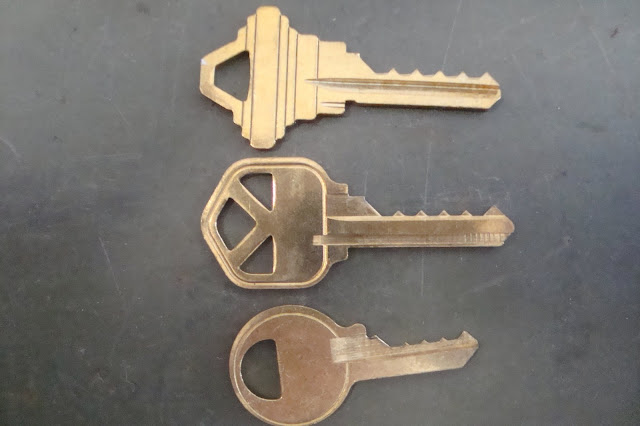We will first discuss the basic tools needed
 |
| From Top to Bottom: Diamond Rake, Ball Rake, Hook, Snake Rake, Bogota Triple, and Bogota Single Pick |
Rakes:
There are many different types of rakes such as Snake Rake, Multi-Diamond Rakes, Bogota Rakes, and Advanced Rakes (these look similar to a key design). This is a more advanced technique that is quicker than using Feeler Picks.
Ball Pick: These come in a Double Ball, Ball and Half ball design, usually used on wafer locks
Half Diamond: This is one of the most versatile picks and comes with most sets. It can be used to pick each pin individually or used to rake.
 |
| Top is a Standard Tension Wrench; Below is a pair of Bogota's. The Bogota's double as a tension wrench, which means less tools needed to be carried. |
Pin Tumbler Lock System
The Pin Tumbler Lock Assembly is the most common lock system it is used on most padlocks, doors knobs, and dead bolt locks.
 |
| Basic Pin Tumbler Assembly |
- The multi-colored red, yellow, blue green, and purple pins are known as the "Bottom Pins".
- Above the "Bottom Pins" are the "Springs" and "Top Pins".
- The red dotted line is the "Shear Line".
- The "Plug" is the light blue rectangle section and is housed inside the "Cylinder". The "Plug" rotates inside the "Cylinder".
A lock opens when a key is inserted by all the "Bottom Pins" aligning with the "Shear Line". When picking a lock you are trying to align the "Bottom Pins" with the "Shear Line" individually while applying light pressure to open the lock.
Tension Wrench Direction
If you do not know what direction to apply pressure with the tension wrench a good technique is to insert the tension wrench apply pressure in one direction and rapidly pull out the pick while holding your ear close to the lock. When your going the right direction you will hear the internal pins drop. You should do every time that you are picking a lock you are not familiar with. Never let tension off the plug or the pins will reset
Feeler Picking
You will want to apply slight pressure with the tension wrench (in the appropriate direction) while inserting the Feeler Pick to the back of the assembly. Gently lift up each pin until it meets the Shear Line, once the pins meet the Shear Line the lock will swing open. This will take practice to get "the feel". It took me about 10 minutes after picking my first time. If you get the "Pin Stack" the cylinder will turn but not completely. Continue picking and the lock will open.
Raking
Raking is an advanced technique of bypassing locks and is usually faster than Feeler Picking. Insert Your Tension Wrench and then your Rake. While gently sliding your rake back and forth (the rake should be gently gliding across the Bottom Pin assembly). When each pin hits the Shear Line the Tension Wrench will continue to turn; once all pins hit the Shear Line the lock will open.
 |
| Bogota Entry Toolset |
Using the Bogota Triple Rake is one of the fastest methods that I know. While applying slight torque with the Tension Wrench; insert the Bogota Rake. With a jittery in-and-out/up-and-down motion; it's pretty effortless and doesn't require the "feel" like traditional picking. You can use the Bogota Single the same as you would a half-diamond pick. Another versatile option is inverting the Bogota Single and it will operate as a hook pick.Purchase Bogota's Here
*When practicing purchase several different tumbler locks from different manufacturers.
Bump Keys
 |
| A group of the most popular Bump Keys. Notice the difference in the 4 and 5 valleys. For 4 and 5 pin locks |
Bump keys can be fashioned by using a file to form a V-Shape in all the "Valleys". Basically in between the point parts or teeth of a key. Do not carve the "Valleys" lower than the indented line on the key.
Bumping a lock is a very fast way to bypass a lock. By inserting the key (one notch or pin from full insertion), gently applying torque (like your trying to turn the key), and tapping the key into the lock--"rapping" the pins into the shear line. This is an effective way to bypass a lock; the problem is that you have to have the Key style for the target lock being bumped. This means a Master lock will need a Master Lock Bump key. In turn you will have to carry ton's of keys to be effective.
I use a screwdriver as the hammer. Commercial bumpkey hammers can be purchased; but holding a screwdriver by its shaft and tapping the key with the handle works well.

